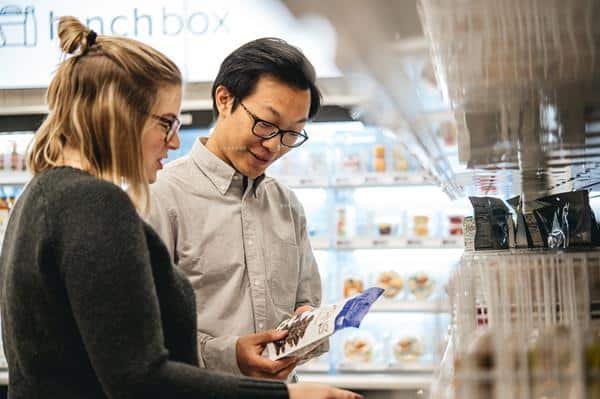Grocery chain operator Ahold Delhaize USA is trying out a cashier-free convenience store format that allows shoppers to buy products without standing in checkout lines.
Similar to Amazon.com Inc.’s Amazon Go convenience store chain, the lunchbox store allows consumers to enter using a mobile app, select the products they want and then walk out. The app charges each customer for their purchases, using one of several payment options, including PayPal, Venmo, Apple Pay and Google Pay.
Ahold Delhaize’s Retail Business Services (RBS) unit, which provides technology services to Ahold Delhaize’s U.S. grocery brands, is testing the lunchbox concept at its Quincy, Massachusetts, headquarters. The store is open only to RBS employees.
It is too early to tell whether Ahold Delhaize (No. 22 in the Internet Retailer 2019 Top 1000) will adapt the technology for use in its grocery stores or open additional lunchbox convenience stores, a spokeswoman says. “Discussions about the future of the technology are ongoing, but no plans are in place at this time,” she says.

The lunchbox store allows consumers to enter using a mobile app, select the products they want to buy and then walk out.
Ahold Delhaize says the lunchbox concept is cheaper to execute compared with other cashierless store concepts, but did not provide a dollar amount. The retailer set up the prototype store in six weeks, while the company was renovating a cafeteria serving more than 1,000 employees at the Quincy facility.
“We developed this solution to meet a need. Our cafeteria was going offline to be renovated. We had a need to provide quick, convenient access to food items for our associates at a variety of hours—both fresh and shelf-stable items. The store we developed was the solution to that challenge. And we think we’ve found a bit of magic in what we developed because we were able to launch the store in just six weeks at a reasonable cost,” the spokeswoman says.
RBS created the new store in collaboration with UST Global, a digital technology services company. RBS led application development, technology connectivity and provided food retail operations expertise. UST and its partners provided artificial intelligence (AI) technology. The store’s AI software—which incorporates Intel Corp.’s Distribution of OpenVINO technology—detects when customers remove products from shelves in the store and uses tracking to connect products to the shoppers who removed them from the shelves.
In collaboration with UST Global and Intel, Ahold Delhaize plans to demonstrate the lunchbox technology the National Retail Federation Big Show conference scheduled for Jan. 12-14 in New York City.
“Lunchbox is an easy, fresh shopping alternative,” says Paul Scorza, executive vice president for information technology and chief information officer for RBS. “Once registered, shoppers simply scan in, shop and walk out. It’s that easy. And it offers fresh, healthy options 24/7. You can grab a snack, a salad, fresh fruit or even a carton of milk on your way home.”
“This is too good an idea with too many benefits not to be widely applied over time,” Bill Bishop, chief architect at grocery and consumer packaged goods consultancy Brick Meets Click, says about cashierless technology. That’s because it solves a big, time-consuming problem: the need for consumers to stand in line.
Currently, the technology has been used primarily in small locations, such as the 18 current Amazon Go stores, which are typically about 2,000 square feet. However, Amazon wants to use the technology to support stores as large as 30,000 square feet, according to news reports.
There is no reason retailers could not use cashier-free technology in larger stores, Bishop says. But he expects retailers to use different techniques as they move to cashierless supermarkets.
For example, the lunchbox store uses anonymous body skeletal tracking—imaging that depicts the joints in the human to represent body parts such as head, neck, shoulders and arms—to connect the right products to the right shoppers. Skeletal tracking works well in small stores with 10 or 12 shoppers present at a given time, Bishop says. Larger stores with more customers might instead track consumers using simpler video cameras—though that might raise privacy concerns, he says.
Ahold Delhaize USA—a division of Netherlands-based Ahold Delhaize—is the parent company for Ahold Delhaize’s U.S. companies. The U.S. operations include the Food Lion, Giant Food, Giant/Martin’s, Hannaford and Stop & Shop grocery chains and Peapod, an online grocer. Together, the U.S. operations include more than 2,000 stores and distribution centers across 23 states.